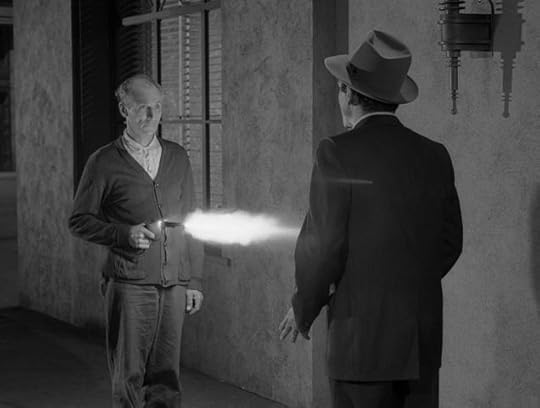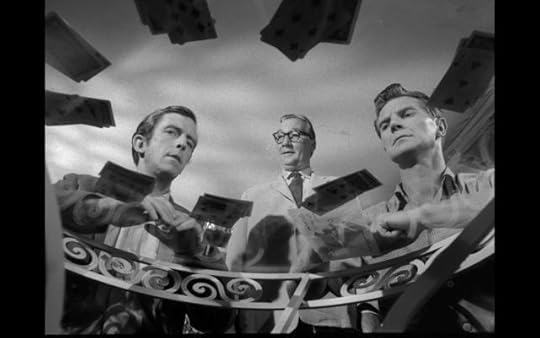July 8, 2024: The Twilight Zone rewatch continues with episodes 13-16!
Episode 13, “The Four of Us Are Dying”
This episode was first broadcast January 1, 1960
This episode was based on an unpublished short story by George Clayton Johnson. Originally titled “All of Us Are Dying”, John’s agent changed it to “Rubber Face” before submitting it to The Twilight Zone for consideration. The production ultimately ended up changing the title to “The Four of Us Are Dying”. Johnson sold another story to the show, Season 1’s “Execution” before going on to script five episodes including the seminal “Kick the Can”. His screenwriting credits would include 1975’s Logan’s Run and the first episode of the original Star Trek series, “Mind Trap”.
The episode’s jazzy score was composed by the great Jerry Goldsmith who would go on to score many notable t.v. and film productions including several Star Trek series and features. His son, Joel Goldsmith, was an equally successful composer for film and television, notable for his tremendous work on the Stargate franchise.
The original plan was to use a single actor for the role of the shape-shifting Arch Hammer, but the transformative make-up was deemed too time-consuming so four different actors were cast, all with the same approximate build.
Harry Townes, who plays the role of Arch Hammer, eventually retired from show business, entered the priesthood and settled down in his hometown of Huntsville, Alabama. Apparently, Townes played a strikingly similar role in an episode of The Incredible Hulk, a story in which a man who is able to change his appearance to resemble others plans to run away with a woman only to be shot and killed at episode’s end.
Actor Ross Martin who plays the persona of musician Johnny Foster found fame opposite Robert Conrad in the ground-breaking Wild, Wild West t.v. series. He and Conrad were in the planning stages of a series reboot when Martin suffered a fatal heart attack. One of Martin’s most memorable roles is opposite Peter Falk in the Columbo episode “Suitable for Framing”. The two played off each other well, and no wonder. Martin was Falk’s acting teacher. I quite enjoyeed this episode.
A great premise, some wonderful performances, a terrific jazzy score by Jerry Goldsmith, and some fun directorial flourishes from John Brahm (Similarly, loved his work on Time Enough At Last but wasn’t quite as enamored of his less successful Judgment Night). This one came together well for me. What did you all think?
Episode 14, “Third from the Sun”
This episode was first broadcast January 8, 1960.
This episode is based on Richard Matheson’s second published short story that appeared in the first issue of Galaxy Science Fiction. Matheson earned $50 for the initial sale of the story, then another $1000 for the film and television rights. There is no conniving Carling character in the original story which is a little more straightforward: the two families get in the car, drive to the launch pad, board the ship and leave.
The flying saucer used in this episode also appeared in Forbidden Planet. The ship’s ambient (background) noise was also used in the Star Trek t.v. series.
The production took pains to introduce futuristic props in the episode including an Ericofon, a then new, state-of-the-art Swedish-designed phone than never really took off. In a similar vein, their getaway car is a modified 1951 Buick Riviera dubbed the Blue Danube, created by designer George Barris for The Time Machine (1960).
The opening scene of the various employees exiting the Ministry of Science was shot on location at the Southern California Edison substation.
The two female characters, Anne and Judi, were named after Rod Serling’s daughters.
On the unique camera angles and the atypical way he shot this episode, director Richard L. Bare said: “Now, these are things I’m against; I would never do that on a straightforward [script], but I had a reason to make the audience wonder what’s going on.”
This was actor Fritz Weaver’s first experience on film and he was in a little over his head those first few days. According to Weaver: “I had to learn the behavioral rules of filmmaking, and I learned them in a hurry. For instance, I had recklessly chosen to smoke a cigarette during one scene. And as I puffed away madly during the masters shots, I had no understanding that I would have to repeat the mad puffing in the close-up [so the shots would match]. So when we went to close-ups, the continuity lady came to me and said, “You had your first puff during the words “the” and “was”.” I told her I couldn’t have possibility done that, and she said yes I did. I quickly learned. And after a harrowing afternoon of doing it many, many times, with many many redos – “You took another puff there, you took another puff there” – I remembered Eddie Andrews, who was my colleague on the show, saying to me after it was all over and I was limp from exhaustion, “Now you know why Gary Cooper keeps his hands in his pockets.””
When speaking at the 1984 Rod Serling retrospective at the Museum of Broadcasting, Weaver had this to say about Serling: “I have vivid memories of Rod Serling during the making of The Twilight Zones I was in. [He was] hanging around like a kid on the set, radiating excitement, having fun. He was generous to performers; he listened, he took suggestions, he gave everybody a free hand. His wide-ranging imagination allowed him to experiment, to take chances, and this was unique.”
This was, apparently, one of the best received episodes to that point if the fan mail they received was anything to go by.
A June 20, 1983 newspaper article cited this episode as Stephen King’s favorite.
I really liked this one – for its clever and weird visual cues, its slow burn suspenseful build, and its out-there twist. Also, Edward Andrews gives an absolutely brilliant performance as their devious co-worker Carling. I mean, who of us hasn’t experienced the duplicity of a Carling in our own work environments? Overall, this one was a rousing success for me. What did you all think?
Episode 15, “I Shot an Arrow into the Air”
This episode was first telecast January 15, 1960.
Rod Serling’s script for this episode was based on an idea pitched to him at a party. Madelon Champion proposed a story about astronauts who crash land on what they assume is an asteroid only to learn, much later, that they are just outside Vegas. For the idea, Champion received a payment of $750 and a brand new refrigerator. Although Serling encouraged outside ideas, this was the only time he ever bought one.
The classic Twilight Zone theme returns for this episode’s opening!
“I Shot an Arrow into the Air” was filmed in the same Death Valley location as previous season 1 episode, “The Lonely”. This time, the crew was better prepared. They were served salads on set while lunch was served poolside back at the hotel, much to their delight.
This was the first episode that Serling was not present on set for shooting.
The episode’s final “It was Earth all along” twist echoes the previous episode’s twist as well as the final revelation in the 1968 Planet of the Apes movie that Rod Serling co-wrote.
Serling’s mid-episode narration (one of only four times it happens in the series run) was added after the final cut because it was felt the sequence needed it. I am of the opinion that it did not and felt unnecessary.
“I Shot an Arrow into the Air” is an underrated episode in many ways with a memorable final twist that really doesn’t make much sense under careful scrutiny. “We never left the Earth,”says Corey. “That’s why nobody tracked us.” Wait, what? Quite the opposite actually. The fact that they never left Earth would have made it far more likely that they would have been tracked. The fact that these intelligent, trained astronauts all conclude that they must be on an asteroid orbiting the sun with atmosphere and an Earth-like gravity somewhat stretches credulity. Finally what a sense of relief in a surprising yet feel good ending…for the bad guy. All in all, a solid episode with a pretty good twist that really forces you to suspend credulity more than your typical sci-fi outing of the era.
Episode 16, “The Hitch-Hiker”
This episode was first broadcast January 22, 1960.
This episode was based on a radio script by Lucille Fletcher. The production beat out Alfred Hitchcock Presents for the television rights, securing them for $2000. Fletcher apparently got the idea for the story while on a road trip with her husband in 1940. On the first day of their trip, she saw the same odd-looking man on the side of the road on two different instances and the experience struck her as strange, and somewhat eerie.
In the original story, the protagonist is a man. Orson Welles voiced the ill-fated driver in the radio version. Rod Serling, however, felt the television adaptation would work better by making the driver a woman.
Swedish-born actress Inger Stevens played the role of Nan Adams. She had been under contract with Paramount but, after turning down several roles, she was put under suspension by the studio. As a result, she switched her focus to the small screen, ultimately landing a part on The Twilight Zone. Stevens had a troubled life, complicated by the various relationships she had with her numerous onscreen co-stars. Bing Crosby, James Mason, Anthony Quinn, Harry Belafonte, Dean Martin, and Burt Reynolds were a few of the romances that ended in heartbreak. At the time of her death, it was revealed that she was secretly married to actor Ike Jones. Her brother supported Jones’s petition to be named administrator of her estate and received half her estate. The other half, Jones gave to children’s charities and mental health organizations.
Inger Stevens’ breakout performance was playing Kathy Holstrum, the Swedish Governess in the 1963 comedy series The Farmer’s Daughter for which she won a Golden Globe and an Emmy nomination. She lost out on the role of Holly Golightly in Breakfast at Tiffany’s to Audrey Hepburn. In 1970, she signed on as the lead in a mystery series, The Most Deadly Game, but passed away less than a week later.
Before taking her own life, Stevens had survived several near-death experiences: a suicide attempt in 1959 just prior to her Twilight Zone appearance, a fiery plane crash in 1961, and an on-set accident while filming the movie Cry Terror! that almost saw her and co-star Rod Steiger succumb to carbon monoxide poisoning.
The circumstances surrounding Stevens’ tragic life cast a dark shadow on what is already a very dark episode of the series. Even though we know Nan’s ultimate destination (the clues along the way are hard to miss), the reveal – and her surrender to fate – still delivers a disturbing final punch. Given what I now know about Stevens, Nan’s ultimate resignation becomes all the more haunting. As much as I love The Twilight Zone’s sci-fi-themed tales, I also adore the surreal stories just as much. The occasional forays into fantasy or descents into horror are always a welcome and unexpected change of pace. I liked this episode a lot and I imagine that, at the time of its first airing, it triggered more than a few sleepless nights.
The post July 8, 2024: The Twilight Zone rewatch continues with episodes 13-16! appeared first on Joseph Mallozzi's Weblog.
Joseph Mallozzi's Blog
- Joseph Mallozzi's profile
- 39 followers







